

In blue is the path of the Umbra on the surface of the Earth (from W to E).
In Red the zone where we would observe a Partial Eclipse.
An Annular Eclipse is like a Total one, but in its lapse the Moon is somewhat farther
from the Earth's orbit, and the cone of its shadow does not reach our planet's surface.
The Sun's Corona is not visible due to the ring of unocculted Sun.
A Hybrid Eclipse is in part Total, in part Annular, depending on the observer's location
along the path of the Umbra on the surface of the Earth.
This eclipse started as Annular in the Southern Pacific Ocean at 18:54 UT,
then became Total from 19:08 UT until 22:00 UT, before reaching Costa Rica.
Before sunset it entered as Annular at the Southern end of Costa Rica and into Panama,
at 22:10 UT, then into Colombia from 22:14 UT until 22:16 UT. It ended in Venezuela, at sunset, after 22:18 UT.
A Partial Eclipse was visible from the South and East of the U.S.A. to the East of South America.
See Solar Eclipses, 2001 - 2010 and Key to Solar Eclipse Maps. (Fred Espenak's Eclipse Home Page)
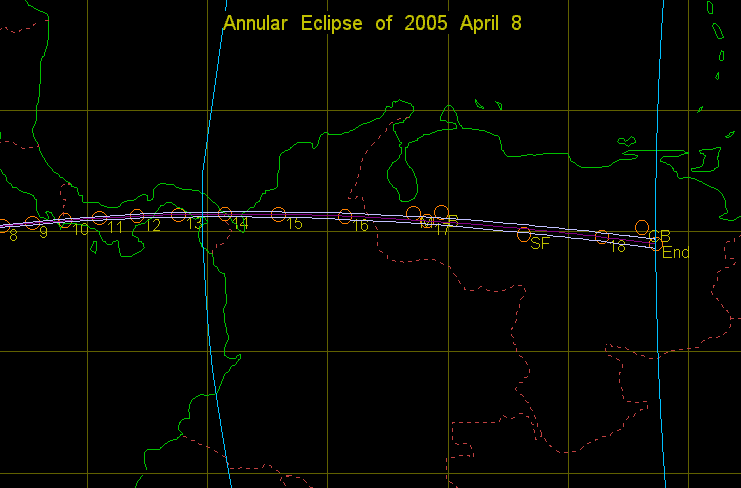
This WinOccult
diagram shows in orange the centers of the Anteumbra from 22:08 to 22:18 UT, as published by
Fred Espenak
(FE-22:08UT to FE-22:18UT, from Costa Rica, Panamá and Colombia to Venezuela),
and shows the locations for Mérida, Barinas, San Fernando de Apure and Ciudad Bolívar (West to East).
It shows the parallels from Lat. 12° to 0° N and the meridians from Long. 82° to 62° W.
The violet curve is the Central Line, the white curves are the limits of the Annular Eclipse.
The blue curves mark the beginning of the sunset interfering with the observation
of the end of the Eclipse,
and the beginning of the sunset interfering with the observation of the maximum of the Eclipse
(eastern End of the Central Line).
More to the East it was possible to observe just the beginning of the Partial Eclipse, before sunset.
An Annular Eclipse can only be seen as central, perfectly concentric, for an instant, from a site in the Central Line.
The complete eclipse was only visible from the Southern extreme of Costa Rica and in Panama.
In Eastern Panama, Colombia and Venezuela the sunset prevented observing the end of the eclipse.
See Animation of the Annular Eclipse Path. (Fred Espenak's Eclipse Home Page)
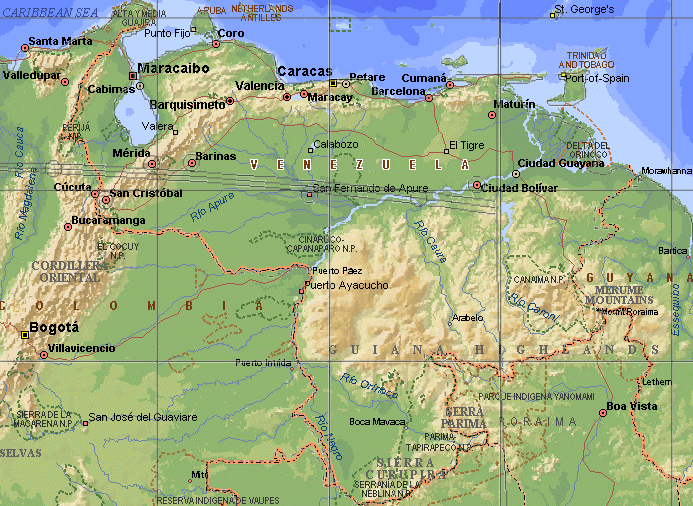
The West-East curves on the overlaid diagram are the North Limit, the Central Line,
and the Southern Limit of the Annular Eclipse.
The North-South curve, near 63° W, is the East Limit of the Annular Eclipse.
FE-22:16UT and FE-22:18UT are shown as gray circles: West of Mérida, in Colombia,
and Southwest of Ciudad Bolívar, North of the mouth of the Caura river on the Orinoco.
The North-South straight lines are the 71° W, 67° W, 63° W, and 59° W meridians.
The West-East straight lines are the 12° N, 8° N, and 4° N parallels.
Mérida - Ciudad Bolívar: 837 Km. (on a straight line)
See Hybrid Solar Eclipse of 2005 April 08 (Fred Espenak's Eclipse Home Page)

The West-East curves on the overlaid diagram are the North Limit, the Central Line,
and the Southern Limit of the Annular Eclipse.
The North-South straight lines are the 72° W and 71° W meridians.
The West-East straight line is the 8° N parallel.
Mérida - San Cristóbal: 151 Km. (on a straight line)
Here the Central Line was 24 Km in total width,
and the maximum of the eclipse was some seconds before 18:17.
See Eclipse Weather and Map Files: Colombia - Venezuela (Jay Anderson).
See Éclipse Annulaire-Totale du 8 Avril 2005 (Patrick Rocher, IMCCE, in French)
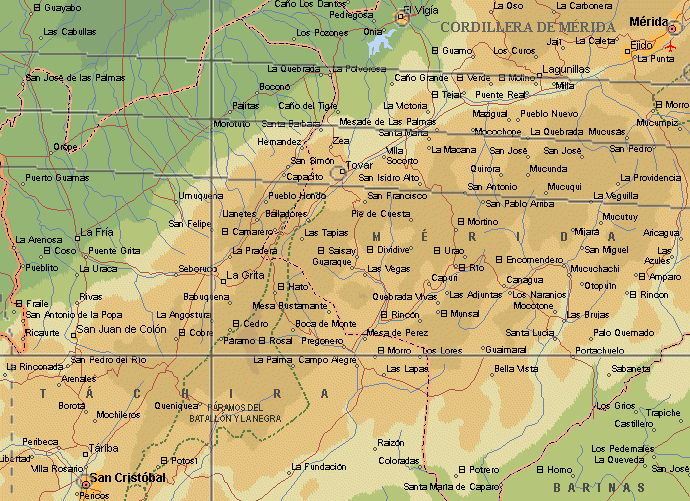
The West-East curves on the overlaid diagram are the North Limit, the Central Line,
and the Southern Limit of the Annular Eclipse.
The North-South straight line is the 72° W meridian.
The West-East straight line is the 8° N parallel.
Mérida - San Cristóbal: 151 Km. (on a straight line)
Here the Central Line was 24 Km in total width,
and the maximum of the eclipse was some seconds before 18:17.
The eclipse was visible in parts from the South of Mérida due to breaks in the cloud cover. Around annularity the decrease and quality change in the daylight was quite evident.
See Eclipse Anular de Sol - 08 de Abril de 2005 Centro de Investigaciones de Astronomía (CIDA) [in Spanish, with photographs of the eclipse]
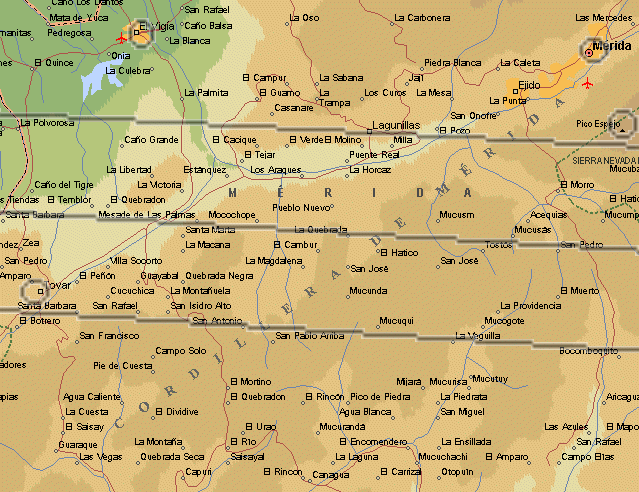
The West-East curves on the overlaid diagram are the North Limit, the Central Line,
and the Southern Limit of the Annular Eclipse.
Mérida - El Vigía: 55 Km. Mérida - Tovar: 74 Km. (on a straight line)
Here the Central Line was 24 Km in total width,
and the maximum of the eclipse was some seconds before 18:17.
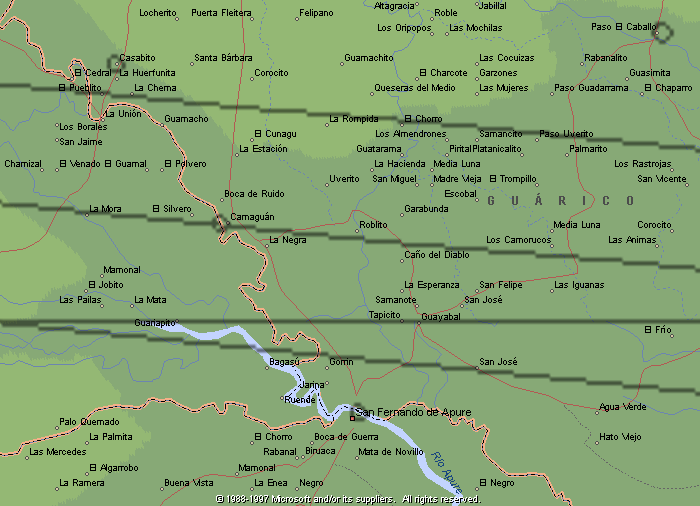
The West-East curves on the overlaid diagram are the North Limit, the Central Line,
and the Southern Limit of the Annular Eclipse.
The West-East straight line is the 8° N parallel.
Camaguán - San Fernando de Apure: 28,6 Km. (on a straight line)
Here the Central Line had a total width of 30 Km,
the maximum of the eclipse was at 18:17:41, and the annularity between 18:17:26 and 18:17:56.
The eclipse was not visible from Camaguán due to a dense cloud cover. But around annularity the decrease and quality change in the daylight was quite evident, and a slight decrease in the ambient temperature.
See Eclipse Weather and Map Files: Central Venezuela (Jay Anderson).
See the eclipse animation for Costa Rica, Panamá, Colombia and Venezuela from Solar Eclipse, April 8, 2005 (Science@NASA)
See Éclipse Annulaire-Totale du 8 Avril 2005 (Patrick Rocher, IMCCE, in French)
| Elevation Scale: | Locations: [gray circles in maps] (approx.) |

|
Barinas: 8° 38' N, 70° 13' W, 200 m ASL |
Circumstances of the Annular Eclipse in Venezuela:
FE-22:16UT, FE-22:17UT, FE-22:18UT are the centers of the anteumbra at those times.
FE-22:16UT is 252 Km West of Mérida (at 18:16:00) [in Colombia].
FE-22:17UT is Southeast of Mérida (at 18:17:00).
FE-22:18UT is 152 Km Southwest of Ciudad Bolívar (at 18:18:00).
The End of the annular eclipse occurred Southeast of Ciudad Bolívar.
In these 2 minutes the anteumbra traveled some 669 Km. From data by
Fred Espenak.
At 18:16:47, 8° above the Western horizon,
the Moon will eclipse 99.3% of the Sun, on the Central Line (central Annular Eclipse),
24 Km South-West of Mérida (there the Central Line is 24 Km in total width).
First Contact at 17:07:09, Second Contact at 18:16:35, Maximum at 18:16:47,
Third Contact at 18:17:00, Sunset at 18:53:41. Duration of the Annular phase: 22 seg.
At 18:16:59, 8° above the Western horizon,
the Moon will occult 99.0% of the Sun (Partial Eclipse), in Mérida,
24 Km North of the Central Line (which has a total width there of 24 Km).
First Contact at 17:07:30, Maximum at 18:16:59, Sunset at 18:53:09.
You must have traveled at least 12 Km South of Mérida to see the Annular Eclipse,
24 Km to see it as central. Santa Bárbara and Santa Cruz de Mora are on the central line.
At 18:17:18, 7° above the Western horizon,
the Moon will occult 98.7% of the Sun (Partial Eclipse), in Barinas,
33 Km North of the Central Line (which has a total width there of 28 Km).
First Contact at 17:08:24, Maximum at 18:17:18, Sunset at 18:49:26.
You must have traveled at least 19 Km South of Barinas to see the Annular Eclipse,
33 Km to see it as central. Ciudad Bolivia is on the central line.
At 18:17:41, 5° above the Western horizon,
the Moon will occult 99.2% of the Sun (central Annular Eclipse), in Camaguán,
the Central Line there has a total width of 30 Km.
First Contact at 17:10:16, Second Contact at 18:17:26, Maximum at 18:17:41,
Third Contact at 18:17:56, Sunset at 18:38:45. Duration of the Annular phase: 27 seg.
The Moon was 13" smaller than the Sun.
At 18:17:34, 4° above the Western horizon,
the Moon will occult 99.0% of the Sun (Annular Eclipse),
23 Km North of San Fernando de Apure,
the Central Line there has a total width of 30 Km.
First Contact at 17:10:14, Maximum at 18:17:35, Sunset at 18:38:02.
You must have traveled at least 12 Km North of San Fernando to see the Annular Eclipse,
23 Km to see it as central. Camaguán is on the central line.
At 18:18:20, 0° above the Western horizon,
the Moon will occult 98.1% of the Sun (Partial Eclipse), in Ciudad Bolívar,
54 Km North of the Central Line (which has a total width there of 33 Km).
First Contact at 17:13:16, Maximum at 18:18:20, Sunset at 18:22:30.
You must have traveled at least 38 Km South of Ciudad Bolívar to see the Annular Eclipse,
54 Km to see it as central.
See Eclipse Weather and Map Files: Eastern Venezuela
(Jay Anderson).
During the Annular Eclipse, the planet Venus will be observable 2.5° East of the Sun.
A Partial Eclipse will be observed before sunset in all of the Venezuelan territory.
First Contact: the Moon begins to enter the disk of the Sun (Beginning of Partial Eclipse).
Second Contact: the whole Moon enters the disk of the Sun (Beginning of Annularity).
Third Contact: the Moon begins to exit the disk of the Sun (End of Annularity).
Fourth Contact: the whole Moon exits the disk of the Sun (End of Partial Eclipse).
For other cities see IMCCE - Circumstances for Various Cities of Venezuela
(in ARVAL)
Path of the Umbral Shadow in Venezuela:
FE-22:16UT: 8° 29.6' N, 73° 26.2' W [West of Mérida, in Colombia]
(Fred Espenak):
Universal Northern Limit Southern Limit Center Line Sun Sun Path Central
------------------ ------------------ ------------------ Alt Azm Width Durat.
Time Latitude Longitude Latitude Longitude Latitude Longitude
° ´ ° ´ ° ´ ° ´ ° ´ ° ´ ° ° km
22:16 08 36.0N 073 35.7W 08 23.2N 073 16.4W 08 29.6N 073 26.2W 11 276 22 0m 23.9s
FE-22:17UT: 8° 21.4' N, 70° 41.6' W [Southeast of Mérida]
(Fred Espenak):
Universal Northern Limit Southern Limit Center Line Sun Sun Path Central
------------------ ------------------ ------------------ Alt Azm Width Durat.
Time Latitude Longitude Latitude Longitude Latitude Longitude
° ´ ° ´ ° ´ ° ´ ° ´ ° ´ ° ° km
22:17 08 29.2N 070 56.0W 08 13.4N 070 26.6W 08 21.4N 070 41.6W 8 - 25 0m 26.8s
FE-22:18UT: 7° 48.4' N, 64° 53.5' W [Southwest of Ciudad Bolívar]
(Fred Espenak):
Universal Northern Limit Southern Limit Center Line Sun Sun Path Central
------------------ ------------------ ------------------ Alt Azm Width Durat.
Time Latitude Longitude Latitude Longitude Latitude Longitude
° ´ ° ´ ° ´ ° ´ ° ´ ° ´ ° ° km
22:18 08 03.4N 065 51.5W - - 07 48.4N 064 53.5W 2 277 32 0m 32.1s
End of the eclipse: 7° 35.4' N, 63° 05.7' W [Southeast of Ciudad Bolívar]
(Fred Espenak):
Universal Northern Limit Southern Limit Center Line Sun Sun Path Central
------------------ ------------------ ------------------ Alt Azm Width Durat.
Time Latitude Longitude Latitude Longitude Latitude Longitude
° ´ ° ´ ° ´ ° ´ ° ´ ° ´ ° ° km
- 07 44.6N 063 05.8W 07 26.2N 063 05.7W 07 35.4N 063 05.7W 0 - 34 00m33.6s
Universal Time is the time UT, the time in Venezuela is UT - 4 hrs.
Northern Limit is the northern limit of the Annular Eclipse
Southern Limit is the southern limit of the Annular Eclipse
Center Line is the center of the anteumbra of the Annular Eclipse (Central Line)
Sun Alt and Azm are the Altitude and Azimut of the Sun on the Central Line
Path Width is the width of the anteumbra of the Annular Eclipse
Central Durat. is the Duration of the Annular Eclipse on the Central Line
Credits:
![]() Original Information from
Eclipse Predictions by Fred Espenak, NASA/GSFC:
Original Information from
Eclipse Predictions by Fred Espenak, NASA/GSFC:
Solar Eclipses, 2001 - 2010,
Hybrid Solar Eclipse of 2005 April 08,
Path of Hybrid Solar Eclipse of 2005 Apr 08.
![]() Calculations and diagrams for the circumstances of the Eclipse by
Calculations and diagrams for the circumstances of the Eclipse by
Andrés Valencia, Caracas, Venezuela.
With the program WinOccult,
International Occultation Timing Association (IOTA)
![]() Calculations, diagrams and Central Line overlays by
Calculations, diagrams and Central Line overlays by
Henry Mendt, Maracaibo, Venezuela.
With the program WinOccult,
International Occultation Timing Association (IOTA)
![]() Geographic maps in color from Microsoft Encarta Virtual Globe (1998 Edition)
Geographic maps in color from Microsoft Encarta Virtual Globe (1998 Edition)
(North up, East to the right)
![]() Warning:
Warning:
Never observe the Sun directly, nor with optical instruments, without the required special filters,
this would result in permanent damage to your eyesight.
Note that the partial eclipse began with the Sun still high in the sky, 25° to 20° above the Western horizon. To aviod irreversible damage to your sight, read this Warning.
To observe an eclipse during its partial phases, without optical instruments, project a small
image of the Sun on a screen of white cardboard, using as a "lens" a tiny hole punctured with
a needle in a piece of aluminum foil.
Set the screen perpendicular to the Sun rays, and the aluminum foil between the screen and the
Sun, parallel to the screen. The distance between the "lens" and the screen determines the
size and brightness of the image.
Mounting the aluminum foil on a light frame, will make it easier to handle. Supporting the
screen on its correct position, will make this device easier to handle.
Constructing the whole device inside a shoebox, with only a sighthole on one of the sides
lets you attain a larger image. Cut a hole into one end to support a small piece of foil with
the pinhole.
To improve image sharpness you could use binoculars or a small telescope as a lens. But there is a risk of damaging them with the accumulated heat, if the image is kept for more than a minute at a time. Make sure nobody looks through them!
See Safe Sunwatching in SpaceWeather.com
An arc-soldering filter #12 to #14, or an Aluminized Mylar Solar filter, let you look at the Sun directly with safety, but dark photographic negatives and smoked glass permit the passing of harmful infrared rays. The filter #12, lighter, is used for observing the Sun after dawn or before sunset, the #14 near noon, the #13 in intermediate situations.
See the articles by B. Ralph Chou (MSc, OD. Associate Professor, School of Optometry, University of Waterloo):
Solar Filter Safety
in Sky and Telescope,
Eye Safety and Solar Eclipses
at the NASA Goddard Space Flight Center,
Solar Eclipse Filters, and
Observing Eclipses Safely
at MrEclipse.com (Fred Espenak).
Be sure to protect and instruct your children!
The damage to your eyesight occurs without pain!
![]() Meteorology:
Meteorology:
According to the graphic
Mean April Daytime Cloud Cover in Percent,
by Jay Anderson,
the average daytime cloud cover in April for the Andean zone of the eclipse would be between 70% and 80%,
for the zone of the Occidental plains between 60% and 70%, and for the Oriental plains between 50% and 60%.
See Eclipse Weather and Map Files (Jay Anderson).
For updated weather maps, see
Caribbean Hires Satellite
(by Intellicast),
or Venezuela Satellite
(The Weather Channel).
And see the forecasts for
Mérida,
Barinas,
San Fernando de Apure,
or
Ciudad Bolívar
(AccuWeather.com).
Links:
See
Eclipse Anular de Sol - 08 de Abril de 2005
Centro de Investigaciones de Astronomía (CIDA) [in Spanish, with photographs of the eclipse]
See Eclipse Anular de Sol: 8 de Abril de 2005 Grupo Universitario de Investigaciones Astronómicas (GUIA) [in Spanish, with photographs of the eclipse]
See El eclipse en imágenes Astrofotografía y Observación [in Spanish, with photographs of the eclipse]
See Eclipse Solar híbrido 8 de Abril de 2005 Página Web de Freddy [in Spanish and English, with photographs of the eclipse, includding the annular phase]
See the Annular Solar Eclipse of May 10 '94 (ARVAL, 128KB GIF Animation, 256 colors)
See Éclipse annulaire-totale du 8 avril 2005 Institut de mecanique celeste et de calcul des ephemerides (Patrick Rocher, IMCCE, in French)
![]() This page was updated on April 25 '05
This page was updated on April 25 '05
Best seen with Font Verdana with MS Internet Explorer.
See
About the Web Pages of Observatorio ARVAL.
Castellano: Eclipse Anular de Sol en Venezuela: 2005, Abril 08
Back: Total or Annular Sun Eclipses in South America (1951 - 2020)
Messages: